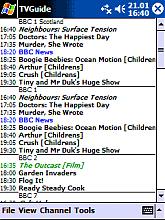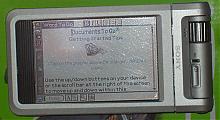Thu January 27 2005
 Rojo invites for Mobileread members Rojo invites for Mobileread members
|
|
07:11 AM by Alexander Turcic in Miscellaneous | Lounge
And now you can have your own invite from Mobileread. We have -five- invites to share with you. The rules: You have to be a registered Mobileread member and actively participating in our discussions (by that we mean no new joiners who are eager to just grap the invite and disappear again). As always, we'd appreciate if you had something nice to say about us (suggestions are also welcomed!). Simply reply to this post. First-comes-first-serves! |
|
[ 6 replies ] |
Sun January 23 2005
 Absence/surgery Absence/surgery
|
|
09:01 AM by Alexander Turcic in Miscellaneous | Announcements The bad news. I have an eye surgery coming up this week and won't be online for some time. The good news. You will probably not even notice my absence thanks to the amazing Mobileread editor team. If anyone of you needs help, count on them! |
|
[ 18 replies ] |
 Sunrise 0.41 released Sunrise 0.41 released
|
|
08:55 AM by Laurens in Archive | Sunrise I just released Sunrise 0.41. Two new features in this release:
[added by Alex: If you are new to Sunrise, click here to find out more about its top-notch features for website offline conversion.] |
|
[ 2 replies ] |
 TVGuide for PocketPC 0.6 released TVGuide for PocketPC 0.6 released
|
|
08:46 AM by Alexander Turcic in Archive | Handhelds and Smartphones
To use TVGuide, you need to download the following three tools (all free): The documentation of each tool is self-explanatory. First start with xmltv, to scrape the latest TV information from an online source of your choice. Then you must use the XML2TVGuide converter to reformat the xmltv files. The resulting converted files you simply copy somewhere on your PPC (I use a new directory on my SD Card). The first time you start TVGuide, it will ask you to point to this location. If you have any questions, feel free to ask. There are at least two other similar products, Pocket TV Listings and Pocket TV Browser. Feel free to check them out as well. |
|
[ 11 replies ] |
 Fictionwise 40% on all 2004 bestsellers Fictionwise 40% on all 2004 bestsellers
|
|
08:23 AM by Alexander Turcic in E-Book General | Deals and Resources (No...
Talking about fair prices for e-books, I think this a good start! |
|
[ 0 replies ] |
Sat January 22 2005
 Customize your MR frontpage (reminder) Customize your MR frontpage (reminder)
|
|
12:12 PM by Alexander Turcic in Miscellaneous | Announcements Here's our periodic reminder that you can customize the appearance of the MobileRead frontpage. For example, you can selectively hide external news sources that you are not interested in. Visit this link for a full overview of your current frontpage settings (you need to be logged in)! Comments and suggestions are always appreciated. |
|
[ 0 replies ] |
 Landscape mode for Sony Clie NX/NZ/TH devices Landscape mode for Sony Clie NX/NZ/TH devices
|
|
11:36 AM by Alexander Turcic in Archive | Handhelds and Smartphones
There is currently no public beta available. According to PDA247, the public demo is scheduled for the second week of February. |
|
[ 4 replies ] |


 What is
What is 
 Yesterday I stumbled over
Yesterday I stumbled over  For a short time only, Fictionwise
For a short time only, Fictionwise  Some said it wasn't possible. Mobile Stream
Some said it wasn't possible. Mobile Stream  Latest E-Books
Latest E-Books

